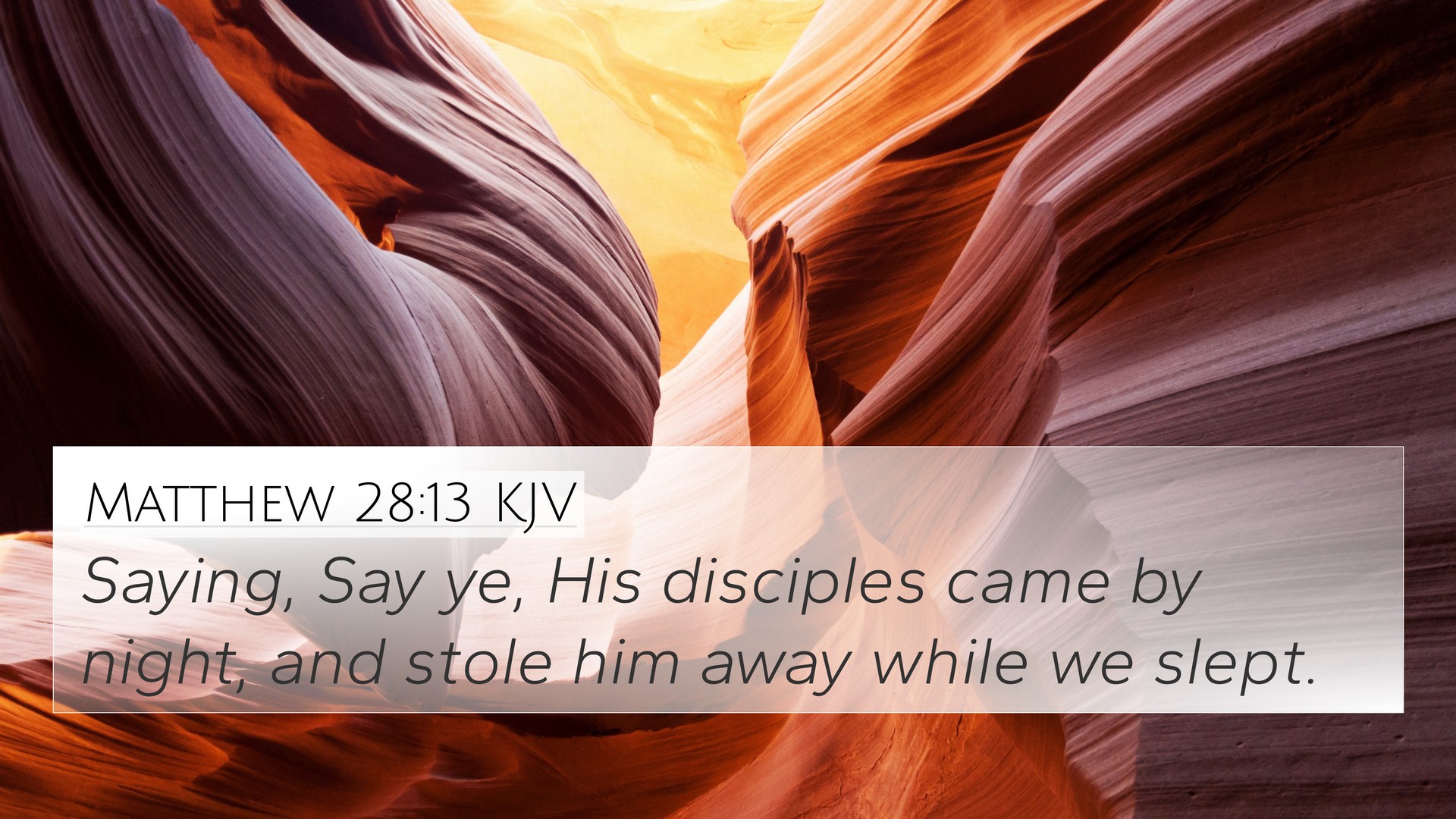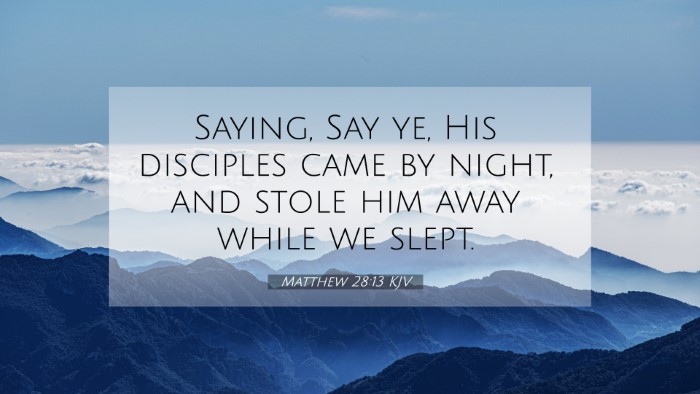Understanding Matthew 28:13
Matthew 28:13 states, "Tell them, ‘His disciples came at night and stole him away while we slept.’" This verse highlights the deceitful narrative that circulated regarding the resurrection of Jesus, as told by the guards. The context surrounding this verse is essential to grasping its meaning and its implications within the broader biblical narrative.
Insights from Public Domain Commentaries
Matthew Henry’s Commentary
Matthew Henry emphasizes the disingenuousness of the priests and elders, as they fabricated a story to explain the empty tomb. He notes that the guards were heavily influenced by their fear of the consequences of the resurrection, leading them to accept money to lie. Henry highlights how this event reflects the nature of truth amidst falsehood, where divine truth stands resilient in the light of human deception.
Albert Barnes’ Commentary
Albert Barnes points out that the chief priests and elders were conscious of the miraculous nature of Jesus’ resurrection; nonetheless, they chose to propagate falsehood. Barnes explains that the claim of the disciples stealing Jesus' body was an attempt to deflect the truth and dismiss the miraculous event surrounding the resurrection. He stresses the inherent motives of these religious leaders, which were founded in self-preservation and the maintenance of their authority over the people.
Adam Clarke’s Commentary
Adam Clarke discusses the broader implications of this verse as it relates to the behavior of human authority in response to divine truths. Clarke articulates that this false accusation sought to undermine the legitimacy of the resurrection, a cornerstone of Christian faith. He correlates this with other historical instances where truth is suppressed, drawing parallels to various scriptural situations where authority figures have attempted to conceal divine realities.
Thematic Connections and Cross-References
Matthew 28:13 has essential thematic links with several other Bible verses. Below are some significant connections that provide further insight into the themes of deception, resurrection, and divine truth within scripture:
- Matthew 27:62-66 - The religious leaders' measures to secure the tomb highlight their awareness of the potential resurrection.
- John 20:13-15 - Mary Magdalene encounters angels at the empty tomb, emphasizing the resurrection's truth against fabricated narratives.
- Acts 2:23-24 - Peter's proclamation of Jesus' resurrection contrasts the lies propagated by the leaders.
- 1 Corinthians 15:14 - The apostle Paul asserts that without the resurrection, Christian faith is futile, reinforcing the importance of truth in the resurrection narrative.
- Matthew 28:11-15 - The passage leading up to verse 13 contains the initial report to the chief priests regarding the resurrection, establishing context for their conspiracy.
- Luke 24:11 - The doubt of the apostles upon hearing the resurrection reports correlates with how truth can sometimes be met with skepticism.
- John 12:9-11 - The plot to kill Lazarus after his resurrection illustrates the extreme lengths to which authorities will go to silence evidence of divine truth.
- Revelation 21:8 - This verse speaks to the ultimate fate of the deceitful, framing the actions of the leaders within eschatological consequences.
- 2 Corinthians 4:2 - Paul discusses renouncing secret and shameful ways, highlighting the stark contrast between divine truth and human deceit.
- Matthew 5:10-12 - Those who stand for truth, like Jesus and his followers, may endure persecution, affirming the apostles' challenges in the face of lies.
Conclusion
The deceptive assertions found in Matthew 28:13 raise profound questions regarding the human tendency to deny or distort truth. The commentaries from Matthew Henry, Albert Barnes, and Adam Clarke collectively illustrate the complexities of faith and the struggle against deception. This verse serves as a reminder of the resilience of divine truth and encourages believers to seek scriptural cross-references that deepen their understanding of biblical narratives.
Resources for Further Study
For those interested in exploring deeper, tools for Bible cross-referencing can enhance understanding of connections within the scriptures. Utilizing a Bible concordance or a Bible cross-reference guide can help readers engage with the rich thematic elements and parallels present throughout the Bible. Learning how to use these references opens up comprehensive avenues for biblical study, enriching one’s faith journey through examination and inter-Biblical dialogue.



